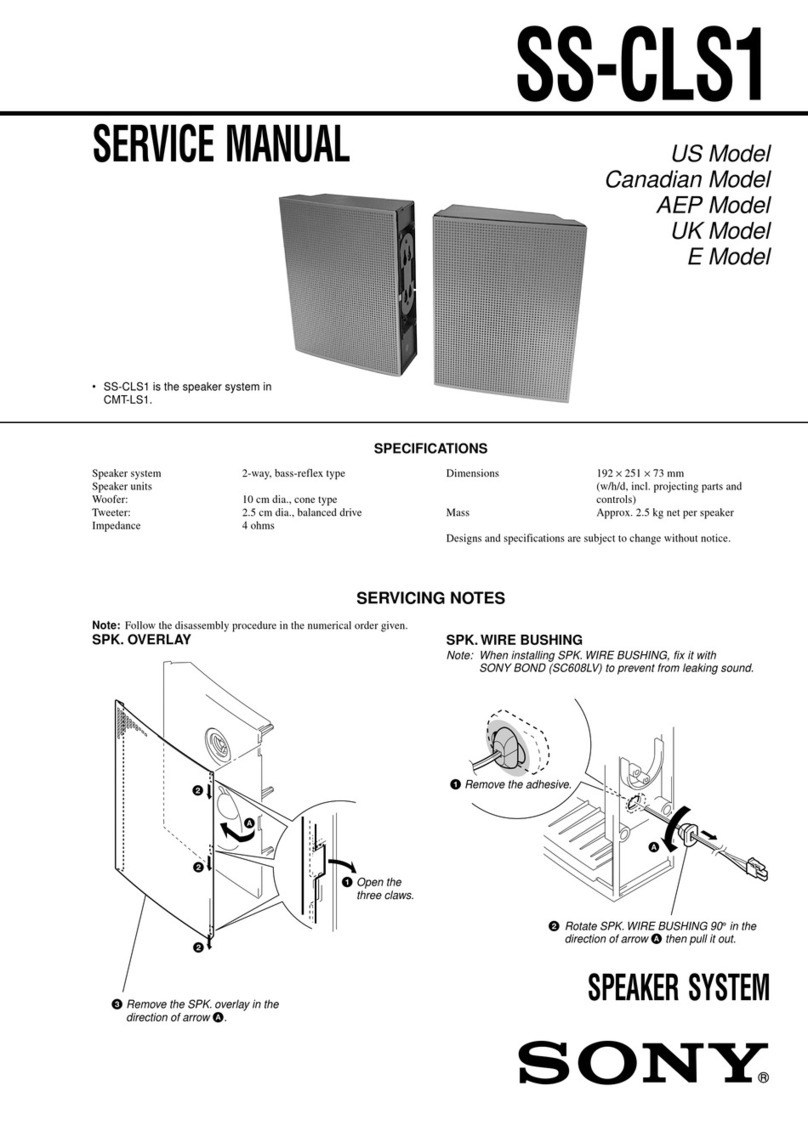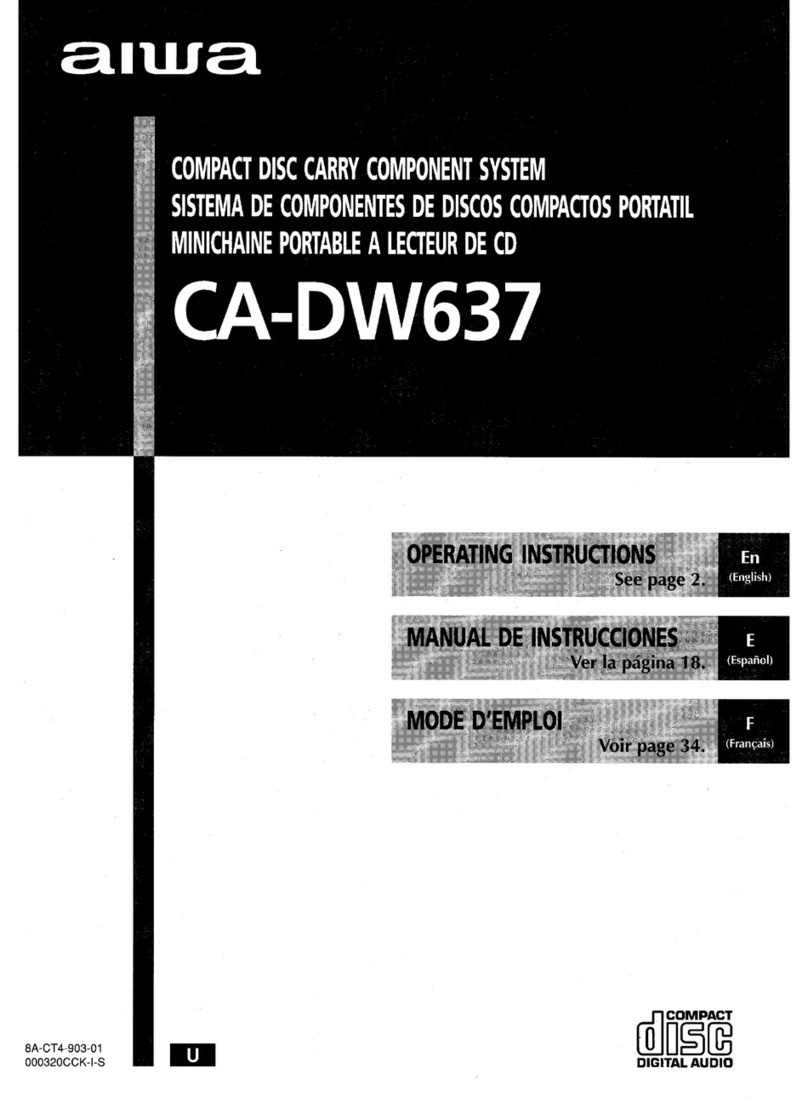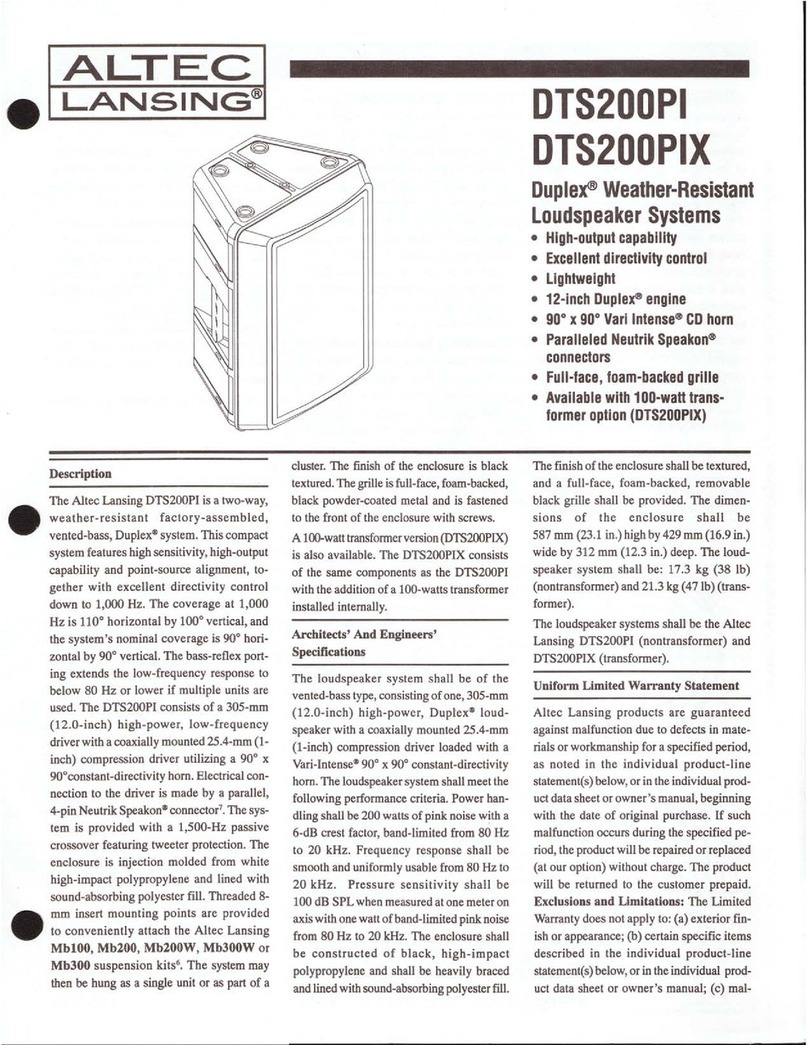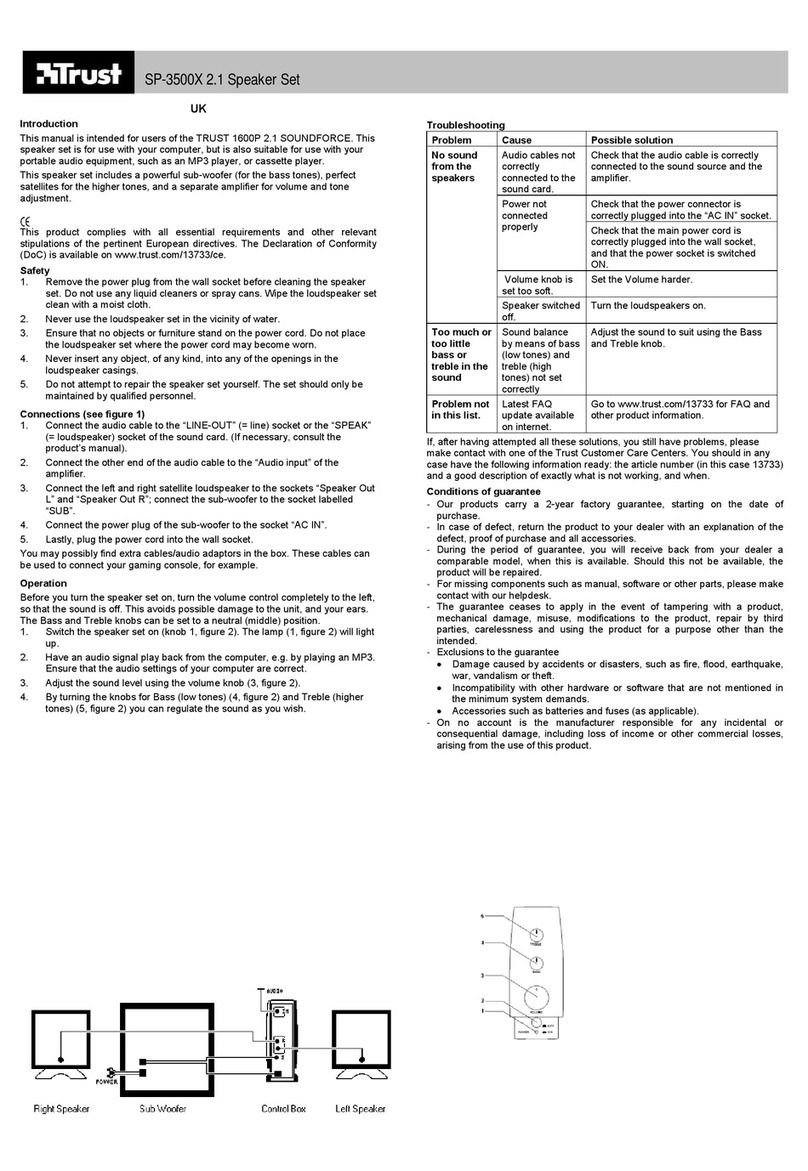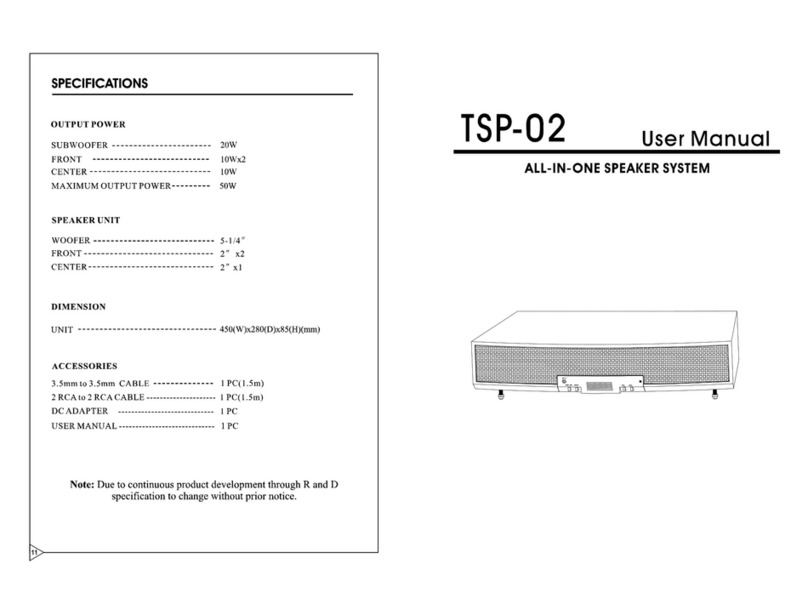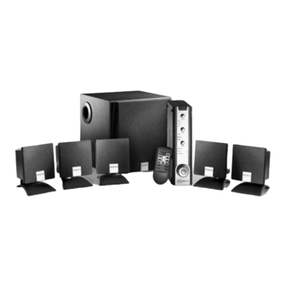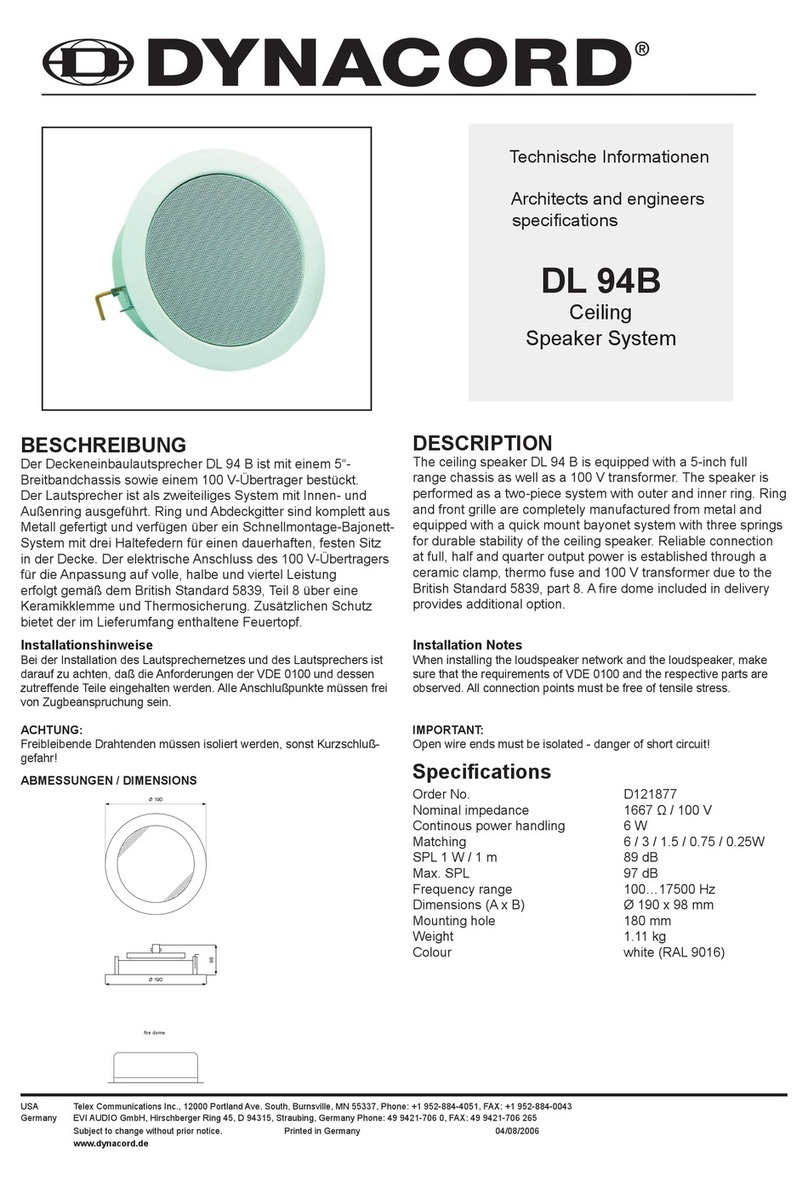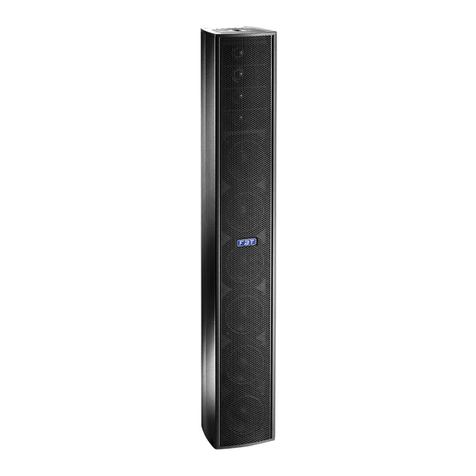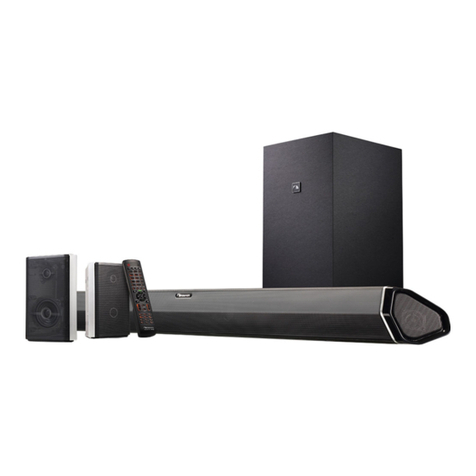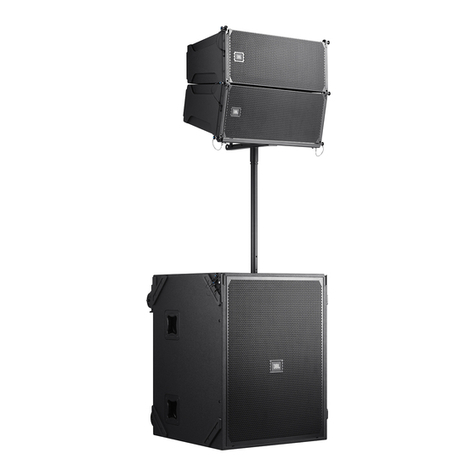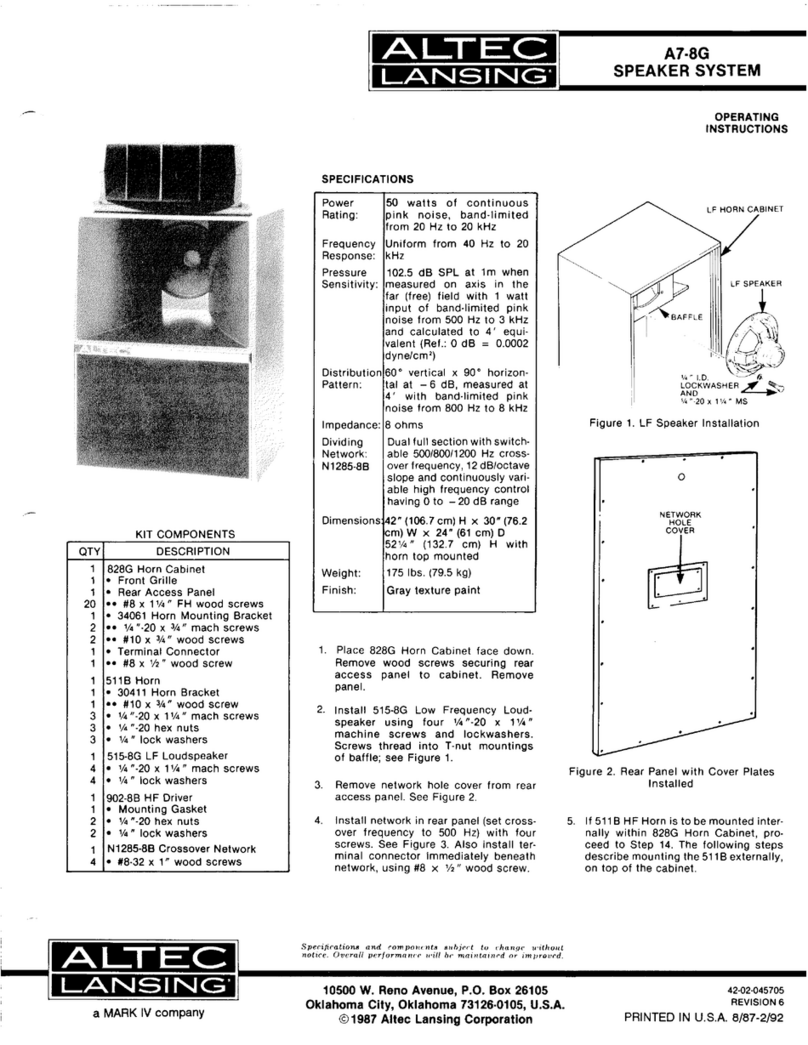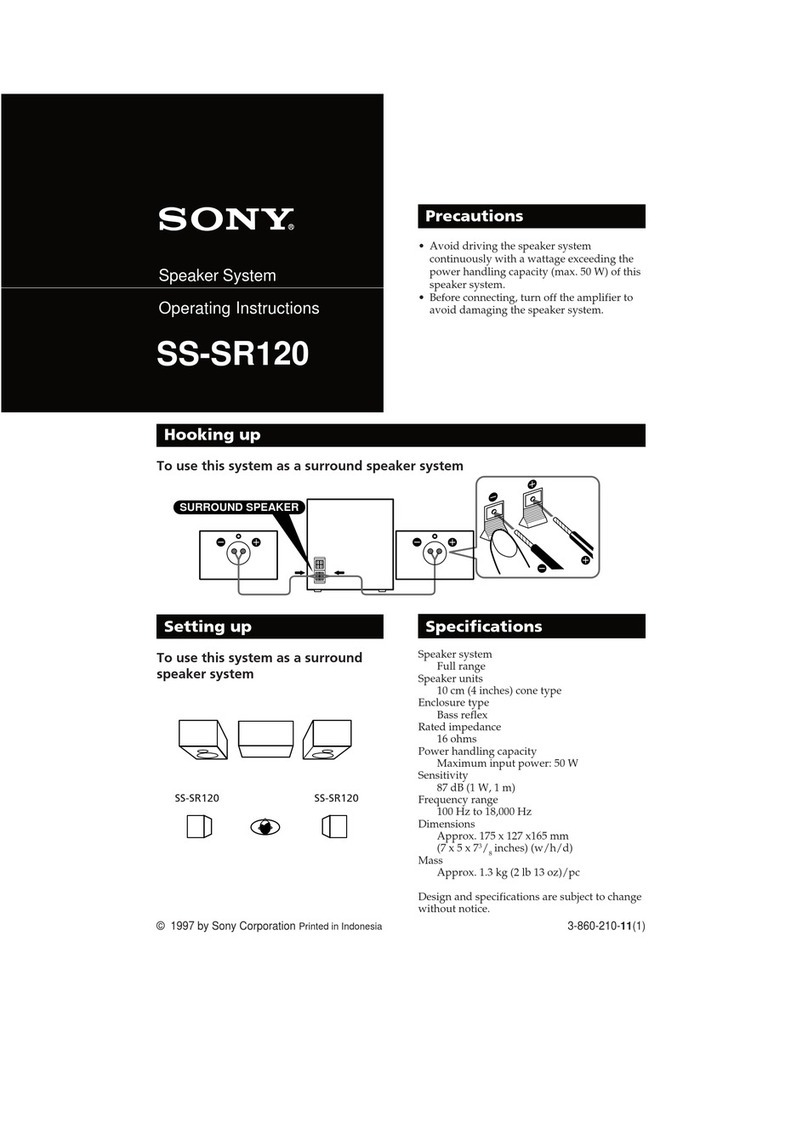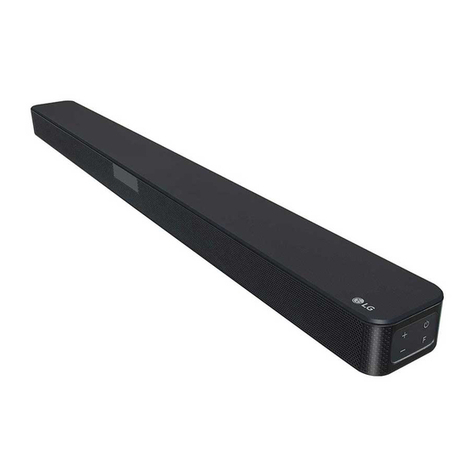Sound Projects SPX Series User manual

S O U N D P R O J E C T S
SOUND PROJECTS
Karperweg 16
1317 SN Almere
The Netherlands
Phone +31 (0)36 53 94 570
Fax +31 (0)36 53 00 578
G
GE
EN
NE
ER
RA
AL
L
I
IN
NF
FO
O
A
AN
ND
D
O
OP
PE
ER
RA
AT
TI
IO
ON
N
M
MA
AN
NU
UA
AL
L
F
FO
OR
R
S
SP
PX
X
S
SE
ER
RI
IE
ES
S™
™

Product info SPX Series
- 1 -
Contents
LINE-ARRAY BASICS ................................................................................................ 1
BASIC SET-UP PRINCIPLES ....................................................................................... 2
QUICK REFERENCE SET-UP GUIDE .......................................................................... 3
SPX FLYING SYSTEM COMPONENTS........................................................................ 3
USING THE SPX MOUNTING BRACKET ................................................................... 5
5 SIMPLE STEPS TO RIG YOUR SPX ARRAY .............................................................. 7
SETUP EXAMPLES .................................................................................................... 9
GROUND-STACKING AN SPX ARRAY .................................................................... 10
GROUNDSTACKING ON TOP OF BASSBINS .......................................................... 12
ADDITIONAL SAFETY GUIDELINES........................................................................ 13
MAINTENANCE ..................................................................................................... 13
SPX SPECSHEET ..................................................................................................... 14
GUIDELINE TO MAXIMUM AMOUNT OF CABINETS .............................................. 15
DECLARATION OF CONFORMITY ......................................................................... 16
All the important notes regarding proper operation of the product and potential danger
or damage to either the user or the equipment, are highlighted in light grey

Line-array basics
What is a line-array?
A line-array is a sound system made up out of a group of identical, omni-directional radiating
elements oriented in a tightly spaced, straight line. If this line is long enough compared to the
wavelength the elements behave acoustically as if it were a single source. The basics of this
principle are employed in today‘s vertical line-array systems.
Because of the physical dimensions of conventional HF compression-drivers it is impossible to
meet the criteria of tight spacing of the sources for the frequency bandwidth it operates. To solve
this most line-array systems use waveguides to convert the circular wave front emerging from a
HF drivers exit to a rectangular plane enabling multiple sources to be tightly spaced.
Furthermore the wave front emerging from the waveguide should have tight vertical dispersion
in order to avoid unwanted interference. The way this is achieved largely determines the vertical
performance of the line-array system at the HF bandwidth.
Line-arrays behaviour differs in some respects remarkably from conventional systems. The
greatest benefit of a line-array is that, when properly designed, the acoustical power of many
cabinets can be combined without the unwanted interference that conventional systems show.
Furthermore its vertical directivity can be adapted to closely fit the venue.
Vertical directivity of a line-array versus a conventional system
While conventional system will almost inevitably cause harmful interference when using more
than one system, a well-designed line-array has the advantage of better acoustic energy
distribution towards the projected area. Although it‘s a misconception that with a line-array no
interference will occur, due to it‘s tight spacing of the omni-directional MF and LF sources most
of the cancellations occur outside the projected area. In fact it is the ‘wanted‘ interference that
creates the ‘bullet-shape‘ often seen in simulation software.
The vertical directivity of the MFs and LFs can be altered within limits by curving the shape of
the array. Due to the HF waveguide‘s tight vertical dispersion, necessary for proper functioning
of the array, curving the array is also bound to outer limits so it doesn‘t create harmful areas of
hotspots and poor HF coverage. The angles of the HF-waveguides in the Dreamline™ have
been configured for optimised performance in relation with the MF/LF-drivers.
Vertical directivity of low frequencies
versus array size
The previously described ‘bullet-shape‘, as a
rule of thumb, applies for wavelengths
equal to or smaller than the vertical array
sizes. For a wavelength equal to the array
length the vertical dispersion will
approximately be 90-degrees. For the
frequencies below this frequency, hence
longer wavelengths, it will gradually turn
into an omni-directional source. Therefore,
vertical directivity control and maximum
SPL of the low and low-mid frequencies
greatly benefit from a larger array size.
Fig.1 Typical characteristic of a 2 meter array
at 170 Hz.

Product info SPX Series
- 2 -
Basic set-up principles
With respect to the horizontal coverage characteristics any SPX system is similar to a
conventional constant directivity (CD) horn/system. When more horizontal coverage is needed
than the horizontal dispersion of one line-array some basic rules apply explained later in this
chapter. The main variable to which a line-array has to be adapted is the vertical coverage.
Establishing proper vertical coverage
The first step in the configuration process is to get the venue parameters and listeners positions
right. It may seem logical but a good preparation is the main time-saver in setting up any audio-
system. Once these parameters, such as distances to first and last listener positions and flying
height, are known prediction software such as SPArC™ can easily be employed to configure the
best flying position.
In general, flying a system higher will bring a more even loudness throughout the audience, and
flying at a lower position will get more loudness at the front listener positions. The highest horn
unit in the SPX array should be aimed at the furthest listening position. In many cases it might
even be preferred to aim just a little above this position.
When a line array is flown it is most logical to configure from top to bottom (far coverage to
near coverage). Therefore it might not always be possible to point the bottom array element to
the nearest listener position to be fed by the line-array (e.g. due to limited number of array
elements). Additional front fill is then necessary. Another situation where front fill is preferred is
when the array is flying relatively high to the first listeners position. In order to avoid 'elevator-
music' coming from above, front fills placed at stage height will place the sound image
downward for the front of the audience.
When a line array is ground stacked it is more logic to configure the array from bottom to top.
Additional front fill can still be used, however often not necessary.
Horizontal coverage
In some cases it might be necessary to use more than one array per side in order to achieve
more horizontal coverage or to be used as in-fills. An important rule applies when this situation
occurs. Instead of placing an array directly besides the first one the proper approach would be
to utilize a second array, which is focused on another portion of the audience and spaced at
least 6-7 meters (approximately 20 ft) away from the first array.
Given this separation, interference only occurs in the low frequency range and there are no
audible intelligibility losses for two reasons: the first main cancellation is shifted lower in
frequency (example, 28 Hz for 2 arrays of the same size, spaced 6 metres) and tends to be
masked or filled in by room reverberation; by focussing the arrays at different panning angles,
comb filtering interaction is lessened since their overlap region is reduced. In addition, the ear
cannot resolve tightly spaced comb filtering notches at higher frequencies throughout the
overlap region.

Product info SPX Series
- 3 -
Quick reference set-up guide
Carefully read this section before suspending the SPX system
Note! The SPX flying system has been designed according to most international
guidelines for overhead suspension. However, local safety legislation may be
applicable and it is the responsibility of the installer to apply these safety guidelines.
SPX flying system components
SPX Mounting Bracket
for single cabinet use
SPX Basic Flyingframe
for use up to 6 cabinets
SPX Flyingframe Extender
For use up to 6 cabinets –
configuration dependant

Product info SPX Series
- 4 -
SPX Flyingframe assembly
for flying up to 6 cabinets or
groundstacking up to 4 cabinets
for flying below or on top of SP18/SP2-10 bassbins
Consult the Guideline to maximum amount of cabinets on page 15 when preparing the
design of an SPX line-array using the SPX flying frame with the flying frame extender.
SPX Connector (2 per cabinet)
Cabinet interconnect
Quick Release Pin (8 per cabinet)
Connector fixes

Product info SPX Series
- 5 -
Using the SPX Mounting Bracket
The SPX mounting bracket is designed for use with a single cabinet when using the middle
fixing hole or 2 cabinets when using the two outer fixing holes.
When used in static fixed installation situations, where no overhead situations are present the
bracket can be used for up to 4 cabinets (using the 2 outer fixing holes).
All items for cabinet fixture are included. Various ways to connect the bracket to wall, ceiling or
construction are applicable. Items for this purpose are optional.
Step 1
When using a clamp or other device
connect the clamp to the bracket. Connect
safety slings to the left and right hole on top
of the bracket if deemed necessary.
Step 2
Once the mounting bracket is prepared for
its intended purpose, the cabinet may be
fixed to the bracket using the Quick Release
Pins. There are three angles possible:
parallel to bracket or tilted 10 or 15 degrees
downwards.
Step 3
ONLY applicable when using two or more
fixing holes!
Connect a second cabinet by means of two
connector plates and 8 quick release pins.

Product info SPX Series
- 6 -
SPX-65 on a tripod using the SPX Mounting bracket
Safety Note: For direct fixes to walls or ceilings ALWAYS use two or more fixtures
suitable for the applicable underground! Consult local rigging legislation regarding
overhead suspension.

Product info SPX Series
- 7 -
5 simple steps to rig your SPX array
Safety Note:
The maximum amount of cabinets to be hoisted by the SPX flying frame is dependent
on the configuration of the intended setup. Due to momentum critical forces on
connectors will increase fast when the lifting point is shifted backwards. Consult table
on page xxx to avoid overload situations!
Step 1
When using the Flying frame extender, start
with assembling the extender to the flying
frame. Then connect the flying frame to the
first cabinet in line with the connectors and
Quick Release Pins and attach the hoist at
the corresponding hole.
Step 2
Lift the frame and cabinet to approximately
head-high position to enable attachment of
the next cabinet. Start with attaching the
two connectors at the cabinet in the array
using the Quick Release Pins.

Product info SPX Series
- 8 -
Step 3
Now lift the adjacent cabinet with one
person a side and attach it to the extending
connectors using two QRPs per side.
Step 4
Connect audio and mains power cabels and
repeat step 2 thru 4 for all cabinets in the
array.
Step 5
Connect audio and power cables and lift
the SPX array to the desired height. Guide
the cables and fix them to avoid extensive
pulling forces at the connectors.

Product info SPX Series
- 9 -
Setup examples
Typical system setup consisting of 3 SPX-65s, 1 SPX-60 (downfill), 2 SP210s and 4 SP18s

Product info SPX Series
- 10 -
Ground-stacking an SPX array
Note: Always use an SPX flying frame with extender to stack an array of SPX cabinets.
When stacking on top of a cluster of bassbins it is highly recommended to secure the
flying frame with connectors to the bassbin.
Up to 4 cabinets can be groundstacked by means of the SPX frame with extender. Setup can be
done either by placing cabinets one by one on top of each other or by pre-assembling the array
on the floor and tipping the complete cluster including frame. The latter is explained below.
Step 1
Pre-assembly the array of cabinets on the floor with the angles between cabinets as needed.
Step 2
Attach the flying frame including extender at the intended angel.

Product info SPX Series
- 11 -
Step 3
Lift the complete ground stack array in an upright position.
Typical groundstack setup consisting of 4 SPX-65s on a flying frame.
Note: the maximum amount of cabinets is largely depending on local circumstances
such as ground-stability, weather influences (e.g. wind) and array shape. Always check
groundstack stability physically and if necessary grant stability using stabilizing lines.

Product info SPX Series
- 12 -
Groundstacking on top of Bassbins
When making a ground stack on top of a bassbin cluster it is highly recommended to use fixing
connectors between the bassbin and the SPX flying frame.
Typical groundstack setup consisting of 3 SPX-65s and 2 SP18s

Product info SPX Series
- 13 -
Additional Safety Guidelines
Before suspending the SPX system be sure you apply the following general safety guidelines.
Standards for flying and rigging are local not universal, therefore it is important for the user
to contact appropriate regulatory agencies concerning relevant standards for specific
applications.
Before suspending any system, always inspect all components of the rigging system for
deformation, corrosion, and damaged or missing parts that could reduce strength and safety
of the rigging system.
Use only load rated hardware.
Never exceed maximum load ratings at any time.
Consult a licensed physical engineer if you are unsure how to proceed.
It is advisable to consult and engage a qualified rigger when making decisions related to
purchase, set-up and use of any equipment and technique that will be used to suspend any
temporary loudspeaker system above areas that will be occupied by persons.
Never tilt the array by pushing or pulling the array at the enclosures itself! The flyingframe is
equipped and designed to be used both as lifting point and tilting point.
Maintenance
Minimum requirements for inspection of flying hardware:
Control all rigging hardware on deformations, irregularities and missing or loose parts before
every use. (User)
Inspect all items at least once a year. (Qualified rigging personnel)
Approval testing by Certified Body every two years. (Official agency)
Like any high performance tool your Sound Projects system needs regular maintenance.
Check all bolts and nuts of your audio systems at least once a year!
Clean fan-grill, foam-grill and cabinet openings with vacuum cleaner and compressed
air to remove excessive dust. Frequency depending on local circumstances.

Product info SPX Series
- 14 -
SPX Specsheet
Model:
SPX-65
SPX-60
SPX-90
Acoustical specifications:
Max. peak SPL @1m:
(crest factor 2 (6 dB))
133dB
134dB
134dB
Freq. response:
60 Hz -20kHz
60 Hz -20kHz
60 Hz -20kHz
Coverage angle:
65H x 15V
60H x 40V rotatable
90H x 60V rotatable
Electrical specifications:
- Drivers:
12”/ 2 x 1”
12”/ 1.4”
12”/ 1.4”
Transient output:
1000W
1000W
1000W
Amplifier(s):
MA1000™ technology
Crossover 4th order:
1000 Hz
1000 Hz
1000 Hz
Lowpass 4th order:
60 Hz
60 Hz
60 Hz
Protection:
D.A.L.C. (Double AudioLogic Control)
Fast double driver-relais turn on/off
Transient (soft power-up)
DC-voltage short-circuit
LED indication:
power-on/signal/protect
Input impedance:
20 kOhms balanced,
10 kOhms unbalanced
Output impedance:
hard-wired to input
Protection threshold:
+4dBU
Mains voltage:
230V (other on request)
Mains frequency:
50/60 Hz
Power cons. Idle:
< 50VA
RMS Full load:
300VA
Additional data:
Cabinet construction:
crossgrain laminated multiplex
Finish:
Nano Armor PU Coating
Size WxHxD (mm):
395x600x405 trapezoid
Rigging points:
integrated SPX flypoints
recessed pole-mount adapter
Audio connectors:
IEC XLR-3 in/out
Main connectors:
powercon in, powercon out
Max. operating temp.:
-10 to 40 C ambient
Weight:
32kg
32kg
32kg
Additional information about SPX Series can be found on our website: www.soundprojects.com

Product info SPX Series
- 15 -
Guideline to maximum amount of cabinets
*Flying frame should be positioned horizontally
ALWAYS consult Sound Projects’proprietary acoustic prediction software SPArC™
(downloadable at www.soundprojects.com) to determine the maximum amount of
cabinets at specific situations. The angle of the flying frame influences the forces on the
flying hardware.
Note: The maximum amount of cabinet as described in the table above are calculated
with double the design factor as described in the ‘Guidelines for Machinery’making it
suitable for overhead suspension in most European communities. (e.g. NPR 8020)
M
MO
OD
DE
EL
L
M
MA
AX
XI
IM
MU
UM
M
N
NU
UM
MB
BE
ER
R
O
OF
F
C
CA
AB
BI
IN
NE
ET
TS
S
*
*
S
SP
PX
X
6
6
6
6
6
6
5
5
4
4
4
4
4
4
S
SP
PL
L
6
6
6
6
6
6
6
6
5
5
4
4
4
4
SPX
SPL

Product info SPX Series
- 16 -
Declaration of Conformity
Almere, 1 October 2010
D
DE
EC
CL
LA
AR
RA
AT
TI
IO
ON
N
O
OF
F
C
CO
ON
NF
FO
OR
RM
MI
IT
TY
Y
SOUND PROJECTS, hereafter referred to as the manufacturer, declares that the SPX rigging
system and its rigging hardware as supplied by the manufacturer are produced and, when
provided with certificate, tested conform CE norms as described in the Guidelines for Machinery
appendix 2A.
SOUND PROJECTS
Karperweg 16
1317 SN Almere
The Netherlands
This manual suits for next models
3
Table of contents
